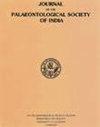印度特提斯-喜马拉雅斯皮提盆地利帕克组首次记录的晚泥盆世-早石炭世孢粉植物及其生物地层学意义
IF 0.6
4区 地球科学
Q4 PALEONTOLOGY
Journal of the Palaeontological Society of India
Pub Date : 2023-09-14
DOI:10.1177/05529360231182233
引用次数: 0
摘要
本文对斯皮提盆地利帕克组(泥盆世晚期-石炭世早期)的孢粉植物记录进行了研究。这项研究在斯皮提山谷和平山谷的三个不同区域进行,以寻找特提斯王国陆生植物的特征,并评估所研究沉积物的相对孢粉年代。Spiti Valley Takche地区附近Lipak组暴露的孢粉组合主要由孢子组成,以Verrucosisporites、Dictyotriletes、Lophozonotriletes、Convolutispora为主,其次为Rugospora、Cymbosporites和Knoxisporites,以及经过加工的花粉粒Plicatipollenites。Pin Valley古岭村Lipak组暴露的孢粉组合包括Spelaeotriletes、Tricidarisporites、Calamospora、Callumispora和改造过的花粉粒。重组后的花粉粒以faunipolenites、scheuringipolenites和Parasaccites为主,其次为densipolenites、Striatopodocarpites、Platysaccus、Alisporites、striomonosaaccites、Chordasporites和verticipolenites。在Pin谷Muth村附近的这个组暴露在孢粉学上是贫瘠的。发现的孢粉植物与印度特提斯王国的孢粉植物记录以及世界范围内同时期序列的孢粉植物记录具有相关性。发现的孢粉组成与西欧的lepidophya - verrucosisporites nitidus (LN)和Vallatisporites verrucosus-Retusotriletes incohatus (VI)组合带和阿根廷的Cordylosporites-Verrucosisporites Biozone非常相似,表明所研究的Lipak组剖面为上法门世至图尔纳世早期。发现的改造后的砾岩属于二叠系,可能是地层渗漏沉积在利帕克组。孢子形态包括Zygopteridiales, Marattiales, Botryopteridales, Equisetales/Noeggerathiales/Sphenophyllales植物群的亲缘孢子。相比之下,花粉粒的古植物学亲缘关系与丝科、Cordaitales和舌科植物群有关。本文章由计算机程序翻译,如有差异,请以英文原文为准。
First record of late Devonian-early Carboniferous palynoflora from the Lipak Formation, Spiti Basin, Tethyan Himalaya, India, and their biostratigraphic implications
The present work elucidates palynofloral records from the Lipak Formation (late Devonian– early Carboniferous) of the Spiti Basin. The study has been carried out from three different sections of Spiti and Pin valleys to look for the signatures of terrestrial plants in the Tethyan realm and assess the relative palynodating of the studied sediments. The recovered palynoassemblage from the exposures of Lipak Formation, near Takche Locality, Spiti Valley, mainly comprises spores and has the dominance of Verrucosisporites, Dictyotriletes, Lophozonotriletes, Convolutispora followed by subordinate occurrences of Rugospora, Cymbosporites and Knoxisporites along with reworked pollen grain Plicatipollenites. The recovered palynoassemblage of Lipak Formation exposure at Guling Village of Pin Valley comprises Spelaeotriletes, Tricidarisporites, Calamospora, Callumispora and reworked pollen grains. The reworked pollen grains are characterised by the dominance of Faunipollenites, Scheuringipollenites and Parasaccites and followed by subordinate occurrences of the Densipollenites, Striatopodocarpites, Platysaccus, Alisporites, Striomonosaccites, Chordasporites and Verticipollenites pollen grains. The exposure of this Formation near Muth Village of Pin Valley is found to be palynologically barren. The recovered palynoflora is correlated with palynofloral records of the Tethyan realm of India and palynofloral records from coeval sequences worldwide. The recovered palynocomposition shows a close resemblance to Retispora lepidophyta–Verrucosisporites nitidus (LN) and Vallatisporites verrucosus–Retusotriletes incohatus (VI) Assemblage zones of Western Europe and Cordylosporites–Verrucosisporites Biozone of Argentina which indicates that studied section of the Lipak Formation is upper Famennian to early Tournaisian age. The recovered reworked palynomorphs belong to the Permian age, which may be deposited in the Lipak Formation through stratigraphic leakage. Palynomorphs include spores of affinities of Zygopteridiales, Marattiales, Botryopteridales, Equisetales/Noeggerathiales/Sphenophyllales group of plants. In contrast, palaeobotanical affinities of pollen grains are linked with the Filicales, Cordaitales and Glossopteridales group of plants.
求助全文
通过发布文献求助,成功后即可免费获取论文全文。
去求助
来源期刊

Journal of the Palaeontological Society of India
PALEONTOLOGY-
CiteScore
1.10
自引率
16.70%
发文量
0
期刊介绍:
The journal is devoted to the publication of original papers and review articles dealing with all aspects of Paleontology, Paleobotany, Stratigraphy, Geochronology, Anthropology and Pre-history.
 求助内容:
求助内容: 应助结果提醒方式:
应助结果提醒方式:


